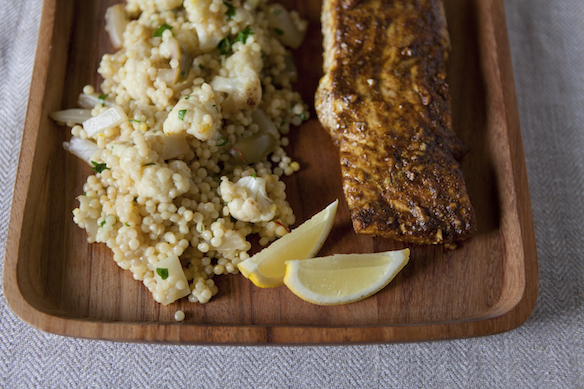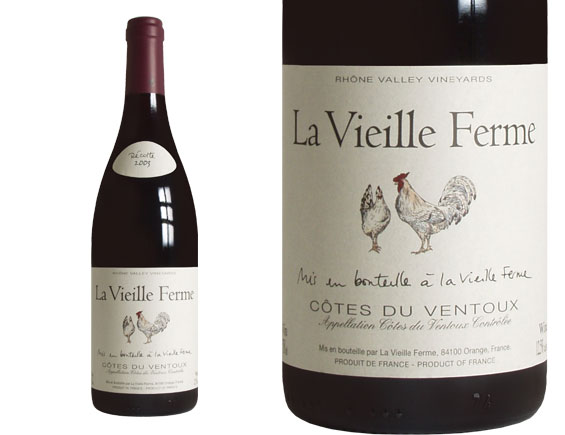
I can’t stop eating halibut. I probably should, because it’s seriously expensive. Plus it sort of spoils you for those times when you have to cook up some perfectly nice flounder or something. The other ocean dwellers sitting at your fishmonger start to feel your scorn, and are all like, “Dang it home cook, I can’t help it if I am not as meaty and sweet and delicate as halibut, but could you stop staring at me like I am your third choice for the Sadie Hawkins dance, because it makes me feel baaaaad!”
Well, they don’t say that. But I get sort of an active imagination when I stare at dead fish. We should probably discuss that later.
But we’ve established here that halibut is really good and I am out to find as many ways to cook it as I can, even though garlic and tomatoes cooked slowly and dumped on top will do just fine. But for a twist on things, I checked out, Saffron-Scented Vegetable Couscous with North African Spiced Halibut just to see how it would all turn out.
In general I am a fan of all North African spices, especially when they are anchored by some decent olive oil and a dash of citrus. This recipe is no exception, and you will find it offers you that weeknight ease, especially when you do as I did and bring the couscous down to bare elements. I actually regretted that; I think the flavors included in the couscous recipe would actually compliment this fish really well and encourage you to make it as deensiebatenvisioned the dish.
A few other things: you are making a paste that the author instructs you to put in a pan first, then place over the fish. In the interest of saving time, I made the marinade in a bowl and just slathered it on my halibut and let it sit on the counter in the baking dish for 30 minutes. I was too heavy of hand with this, and I overwhelmed this delicate fish a bit; it was sort of like a leather skirt when the outfit called for tulle. Don’t be aggressive.
Finally, I am not a big fan of cooking fish at 350. I say kick that oven to a full 425 and just watch it carefully so as not to overcook. My family was a huge fan of this recipe. Why? I asked the Incipient. “Because it just tastes really good.” I have nothing to add to that.
Serves 4
Halibut:
- 1/3 cup olive oil
- 2 cloves garlic, presed or minced
- 1 tablespoon lemon juice
- 1/2 teaspoon salt
- 2 teaspoons paprika
- 2 teaspoons ground cumin
- 1/2 teaspoon cardamom
- 1/2 teaspoon coriander
- 1/2 teaspoon turmeric
- 1/4 teaspoon nutmeg
- 1/4 teaspoon cinnamon
- 1/4 teaspoon cloves
- 1 pound halibut
Couscous:
- 2 tablespoons olive oil, divided
- 1 bulb fennel, trimmed and cut into bite-sized wedges
- 1/2 small cauliflower, cored and broken into bite-sized florets
- 2 cups Israeli couscous (also called pearl couscous)
- 1 pinch saffron
- 1/2 teaspoon salt
- 1/4 cup green olives, quartered
- 1 handful parsley, roughly chopped
- 1 handful cilantro, roughly chopped
- 1 lemon, cut in wedges
- Preheat the oven to 350 degrees.
- Assemble the halibut marinade: in a bowl large enough to accommodate the halibut, mix together the olive oil, garlic, lemon juice, salt and spices. Taste, adding more salt if desired. Add the halibut, spooning the marinade over the top. Marinate at room temperature for ~30 minutes (the marinade has citrus, so you don't want to over-marinate for fear of mushy fish).
- When the fish has marinated, transfer it into a baking dish. Scrape out any remaining spice paste from the marinade dish, and spread thickly on top of the fillets. Bake until the fish is done and flakes easily, 25-30 minutes.
- While the halibut is baking, prepare the vegetable couscous. Heat a large pot over a high heat. Add 1 tablespoon of the olive oil, then add the fennel and cauliflower. Sprinkle with salt. Cook, stirring occasionally, until the vegetables begin to caramelize and develop light brown spots. Add a few tablespoons water and cover to steam, stirring occasionally, until the vegetables are tender (2-5 minutes). Remove from pot, and place in a large serving bowl.
- In the same pot, add the remaining tablespoon olive oil. Add the couscous and cook, stirring occasionally, until the couscous toasts and darkens slightly (just a couple minutes). Add 2 1/2 cups water, crumble in the saffron, and add the salt. Bring to a boil, cover, and lower the heat just enough to maintain a simmer. Cook until the water is absorbed and the couscous is tender, ~10 minutes.
- While the couscous is cooking, assemble the remaining ingredients. Add the olives, parsley, and cilantro to the serving dish with the cooked cauliflower and fennel. When the couscous is done, tip it into the bowl with the herbs and vegetables, and toss well. Scoop the couscous onto plates, and top with the marinated halibut. Serve with lemon wedges.






